Organisational Behaviour Report: Morrisons Culture, Motivation, Teams
VerifiedAdded on 2023/01/12
|14
|4629
|30
Report
AI Summary
This report provides an in-depth analysis of organizational behavior (OB) within Morrisons, a leading UK supermarket chain. The report begins by assessing how organizational culture, power dynamics, and workplace politics affect individual and team behavior, referencing Handy's model of culture. It then explores the implications of various motivational theories and techniques, including Alderfer's ERG theory and Vroom's Expectancy theory, and their application to Morrisons' context. Furthermore, the report differentiates between effective and ineffective teams, discussing factors that contribute to team success. Finally, it examines various philosophical concepts of OB, offering insights into how Morrisons can foster a positive and productive work environment for its employees. The report concludes with a summary of key findings and recommendations.
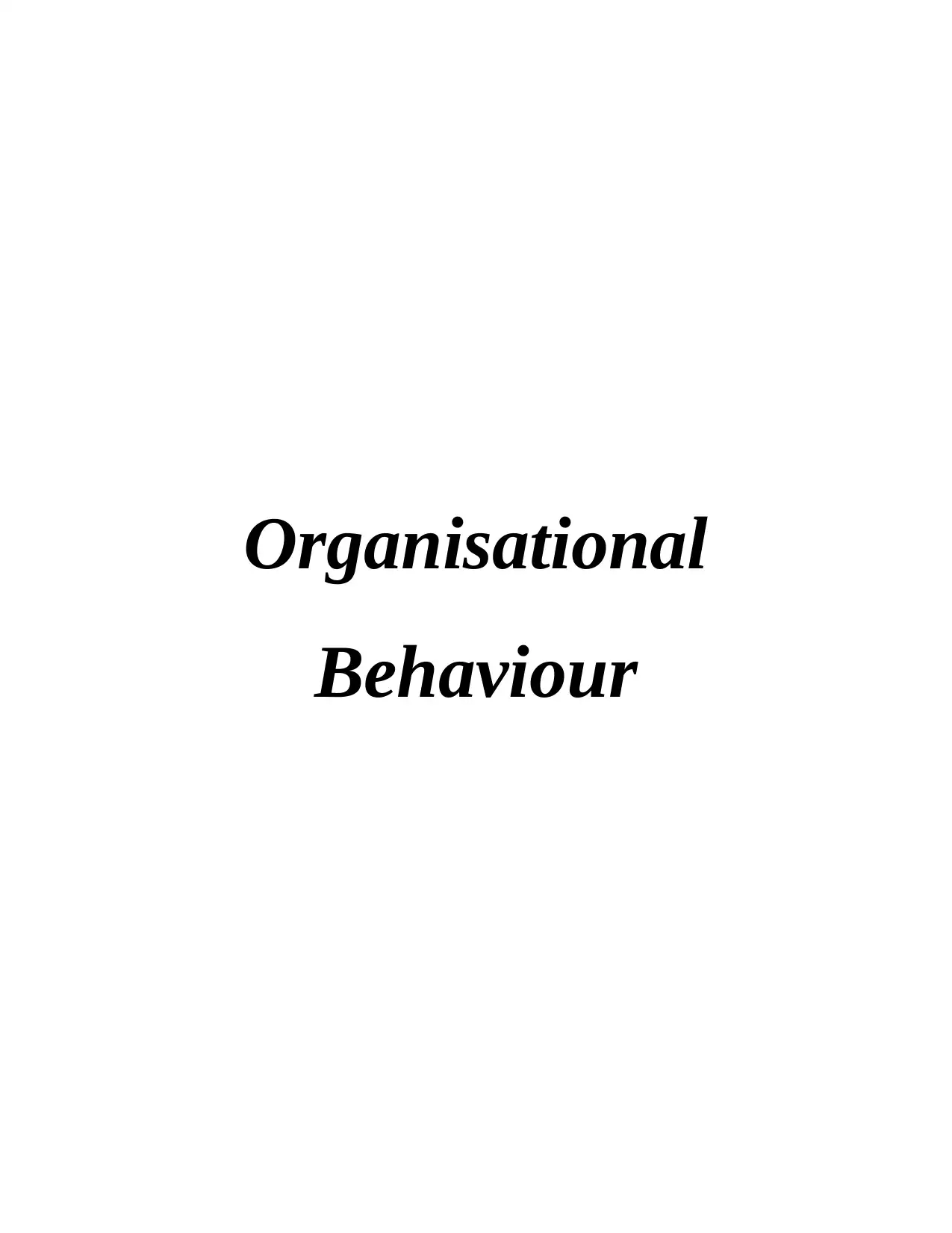
Organisational
Behaviour
Behaviour
Paraphrase This Document
Need a fresh take? Get an instant paraphrase of this document with our AI Paraphraser
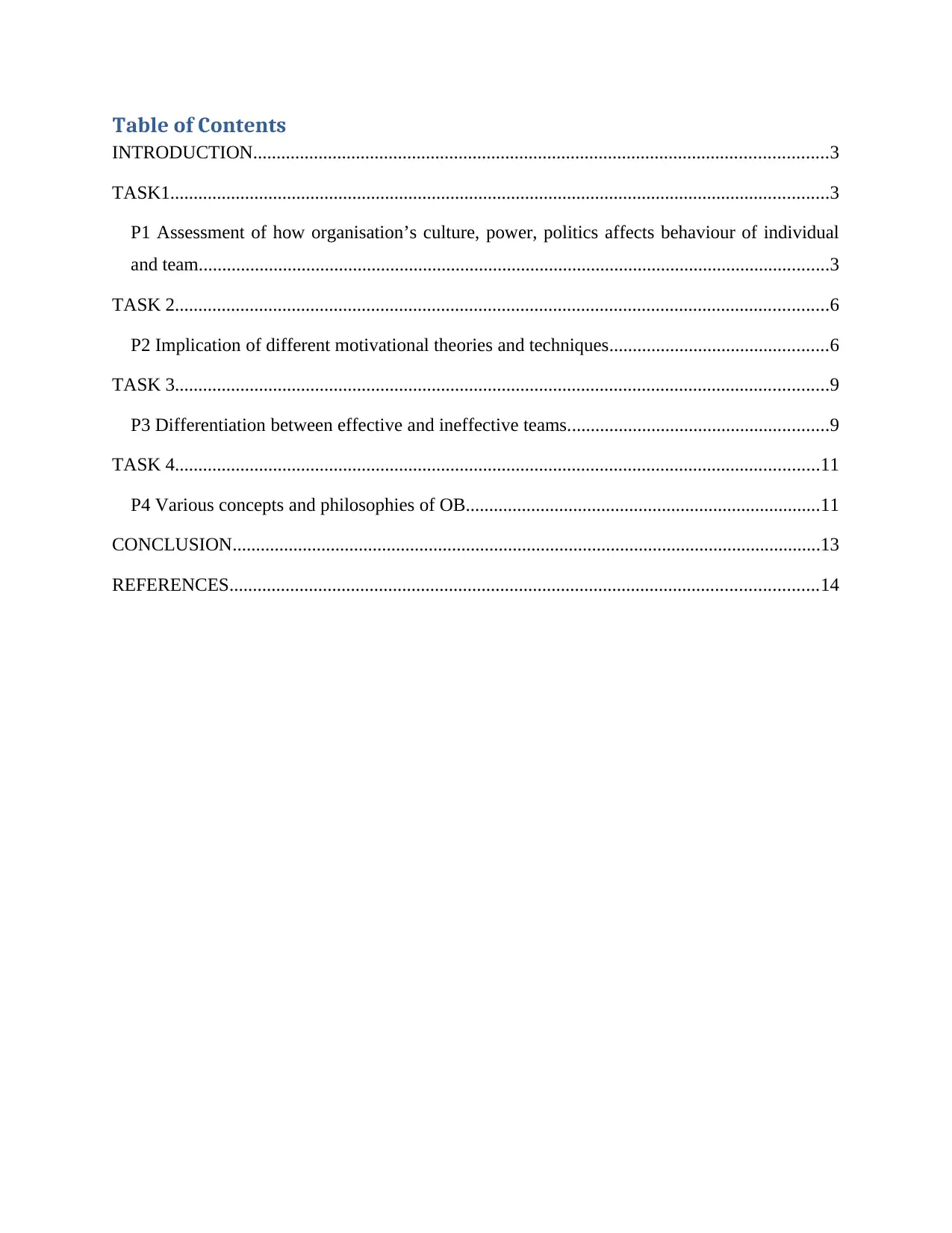
Table of Contents
INTRODUCTION...........................................................................................................................3
TASK1.............................................................................................................................................3
P1 Assessment of how organisation’s culture, power, politics affects behaviour of individual
and team.......................................................................................................................................3
TASK 2............................................................................................................................................6
P2 Implication of different motivational theories and techniques...............................................6
TASK 3............................................................................................................................................9
P3 Differentiation between effective and ineffective teams........................................................9
TASK 4..........................................................................................................................................11
P4 Various concepts and philosophies of OB............................................................................11
CONCLUSION..............................................................................................................................13
REFERENCES..............................................................................................................................14
INTRODUCTION...........................................................................................................................3
TASK1.............................................................................................................................................3
P1 Assessment of how organisation’s culture, power, politics affects behaviour of individual
and team.......................................................................................................................................3
TASK 2............................................................................................................................................6
P2 Implication of different motivational theories and techniques...............................................6
TASK 3............................................................................................................................................9
P3 Differentiation between effective and ineffective teams........................................................9
TASK 4..........................................................................................................................................11
P4 Various concepts and philosophies of OB............................................................................11
CONCLUSION..............................................................................................................................13
REFERENCES..............................................................................................................................14
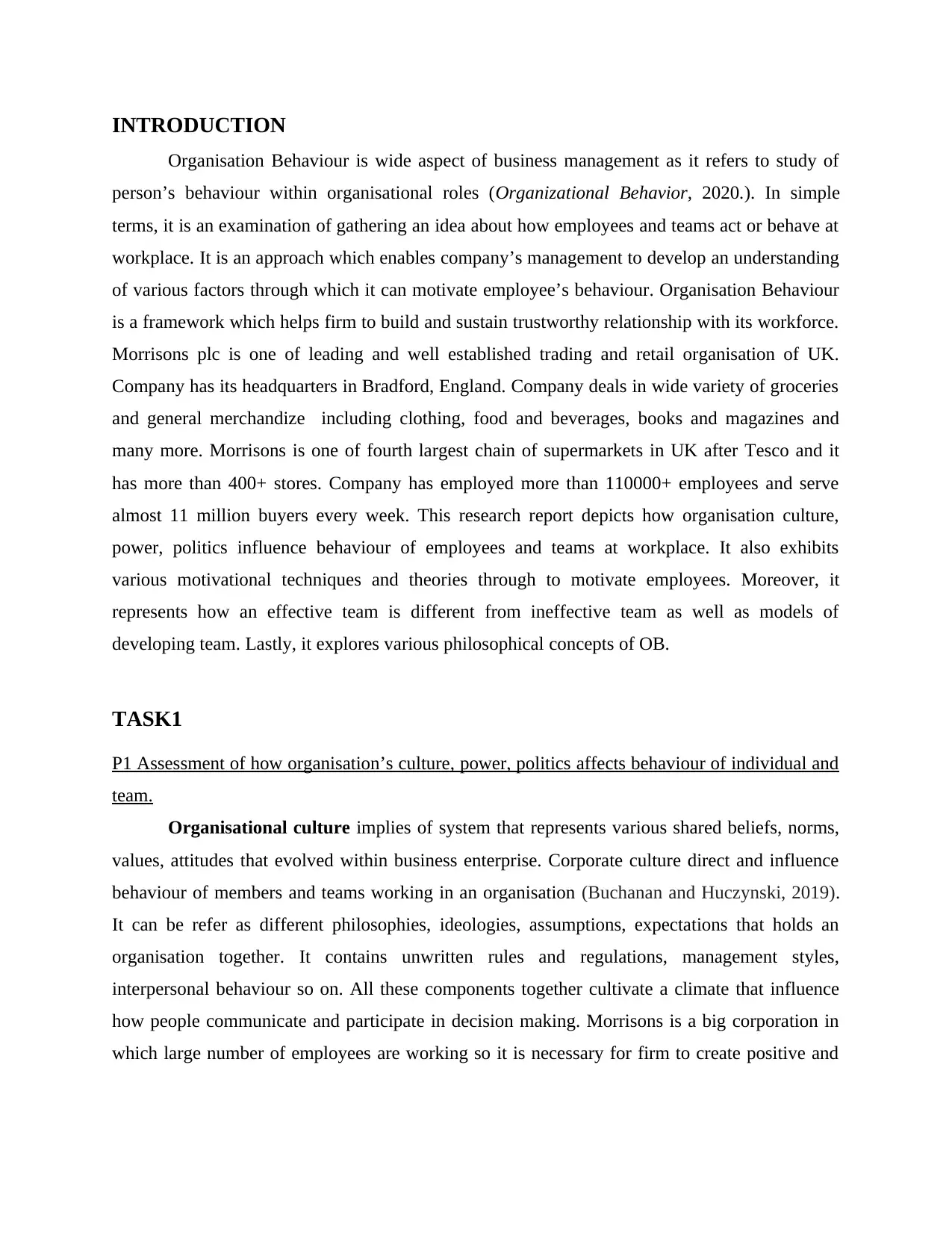
INTRODUCTION
Organisation Behaviour is wide aspect of business management as it refers to study of
person’s behaviour within organisational roles (Organizational Behavior, 2020.). In simple
terms, it is an examination of gathering an idea about how employees and teams act or behave at
workplace. It is an approach which enables company’s management to develop an understanding
of various factors through which it can motivate employee’s behaviour. Organisation Behaviour
is a framework which helps firm to build and sustain trustworthy relationship with its workforce.
Morrisons plc is one of leading and well established trading and retail organisation of UK.
Company has its headquarters in Bradford, England. Company deals in wide variety of groceries
and general merchandize including clothing, food and beverages, books and magazines and
many more. Morrisons is one of fourth largest chain of supermarkets in UK after Tesco and it
has more than 400+ stores. Company has employed more than 110000+ employees and serve
almost 11 million buyers every week. This research report depicts how organisation culture,
power, politics influence behaviour of employees and teams at workplace. It also exhibits
various motivational techniques and theories through to motivate employees. Moreover, it
represents how an effective team is different from ineffective team as well as models of
developing team. Lastly, it explores various philosophical concepts of OB.
TASK1
P1 Assessment of how organisation’s culture, power, politics affects behaviour of individual and
team.
Organisational culture implies of system that represents various shared beliefs, norms,
values, attitudes that evolved within business enterprise. Corporate culture direct and influence
behaviour of members and teams working in an organisation (Buchanan and Huczynski, 2019).
It can be refer as different philosophies, ideologies, assumptions, expectations that holds an
organisation together. It contains unwritten rules and regulations, management styles,
interpersonal behaviour so on. All these components together cultivate a climate that influence
how people communicate and participate in decision making. Morrisons is a big corporation in
which large number of employees are working so it is necessary for firm to create positive and
Organisation Behaviour is wide aspect of business management as it refers to study of
person’s behaviour within organisational roles (Organizational Behavior, 2020.). In simple
terms, it is an examination of gathering an idea about how employees and teams act or behave at
workplace. It is an approach which enables company’s management to develop an understanding
of various factors through which it can motivate employee’s behaviour. Organisation Behaviour
is a framework which helps firm to build and sustain trustworthy relationship with its workforce.
Morrisons plc is one of leading and well established trading and retail organisation of UK.
Company has its headquarters in Bradford, England. Company deals in wide variety of groceries
and general merchandize including clothing, food and beverages, books and magazines and
many more. Morrisons is one of fourth largest chain of supermarkets in UK after Tesco and it
has more than 400+ stores. Company has employed more than 110000+ employees and serve
almost 11 million buyers every week. This research report depicts how organisation culture,
power, politics influence behaviour of employees and teams at workplace. It also exhibits
various motivational techniques and theories through to motivate employees. Moreover, it
represents how an effective team is different from ineffective team as well as models of
developing team. Lastly, it explores various philosophical concepts of OB.
TASK1
P1 Assessment of how organisation’s culture, power, politics affects behaviour of individual and
team.
Organisational culture implies of system that represents various shared beliefs, norms,
values, attitudes that evolved within business enterprise. Corporate culture direct and influence
behaviour of members and teams working in an organisation (Buchanan and Huczynski, 2019).
It can be refer as different philosophies, ideologies, assumptions, expectations that holds an
organisation together. It contains unwritten rules and regulations, management styles,
interpersonal behaviour so on. All these components together cultivate a climate that influence
how people communicate and participate in decision making. Morrisons is a big corporation in
which large number of employees are working so it is necessary for firm to create positive and
⊘ This is a preview!⊘
Do you want full access?
Subscribe today to unlock all pages.

Trusted by 1+ million students worldwide
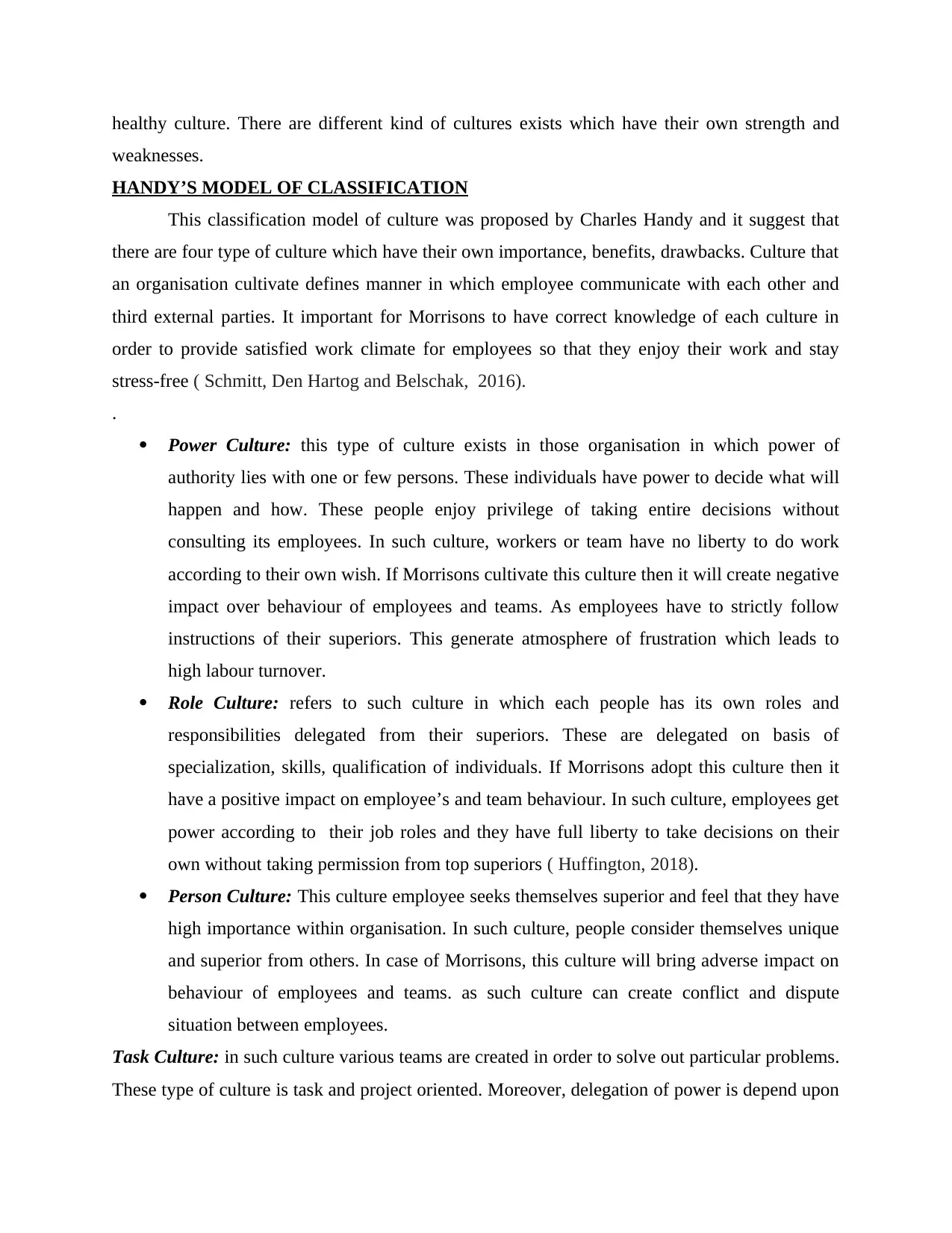
healthy culture. There are different kind of cultures exists which have their own strength and
weaknesses.
HANDY’S MODEL OF CLASSIFICATION
This classification model of culture was proposed by Charles Handy and it suggest that
there are four type of culture which have their own importance, benefits, drawbacks. Culture that
an organisation cultivate defines manner in which employee communicate with each other and
third external parties. It important for Morrisons to have correct knowledge of each culture in
order to provide satisfied work climate for employees so that they enjoy their work and stay
stress-free ( Schmitt, Den Hartog and Belschak, 2016).
.
Power Culture: this type of culture exists in those organisation in which power of
authority lies with one or few persons. These individuals have power to decide what will
happen and how. These people enjoy privilege of taking entire decisions without
consulting its employees. In such culture, workers or team have no liberty to do work
according to their own wish. If Morrisons cultivate this culture then it will create negative
impact over behaviour of employees and teams. As employees have to strictly follow
instructions of their superiors. This generate atmosphere of frustration which leads to
high labour turnover.
Role Culture: refers to such culture in which each people has its own roles and
responsibilities delegated from their superiors. These are delegated on basis of
specialization, skills, qualification of individuals. If Morrisons adopt this culture then it
have a positive impact on employee’s and team behaviour. In such culture, employees get
power according to their job roles and they have full liberty to take decisions on their
own without taking permission from top superiors ( Huffington, 2018).
Person Culture: This culture employee seeks themselves superior and feel that they have
high importance within organisation. In such culture, people consider themselves unique
and superior from others. In case of Morrisons, this culture will bring adverse impact on
behaviour of employees and teams. as such culture can create conflict and dispute
situation between employees.
Task Culture: in such culture various teams are created in order to solve out particular problems.
These type of culture is task and project oriented. Moreover, delegation of power is depend upon
weaknesses.
HANDY’S MODEL OF CLASSIFICATION
This classification model of culture was proposed by Charles Handy and it suggest that
there are four type of culture which have their own importance, benefits, drawbacks. Culture that
an organisation cultivate defines manner in which employee communicate with each other and
third external parties. It important for Morrisons to have correct knowledge of each culture in
order to provide satisfied work climate for employees so that they enjoy their work and stay
stress-free ( Schmitt, Den Hartog and Belschak, 2016).
.
Power Culture: this type of culture exists in those organisation in which power of
authority lies with one or few persons. These individuals have power to decide what will
happen and how. These people enjoy privilege of taking entire decisions without
consulting its employees. In such culture, workers or team have no liberty to do work
according to their own wish. If Morrisons cultivate this culture then it will create negative
impact over behaviour of employees and teams. As employees have to strictly follow
instructions of their superiors. This generate atmosphere of frustration which leads to
high labour turnover.
Role Culture: refers to such culture in which each people has its own roles and
responsibilities delegated from their superiors. These are delegated on basis of
specialization, skills, qualification of individuals. If Morrisons adopt this culture then it
have a positive impact on employee’s and team behaviour. In such culture, employees get
power according to their job roles and they have full liberty to take decisions on their
own without taking permission from top superiors ( Huffington, 2018).
Person Culture: This culture employee seeks themselves superior and feel that they have
high importance within organisation. In such culture, people consider themselves unique
and superior from others. In case of Morrisons, this culture will bring adverse impact on
behaviour of employees and teams. as such culture can create conflict and dispute
situation between employees.
Task Culture: in such culture various teams are created in order to solve out particular problems.
These type of culture is task and project oriented. Moreover, delegation of power is depend upon
Paraphrase This Document
Need a fresh take? Get an instant paraphrase of this document with our AI Paraphraser
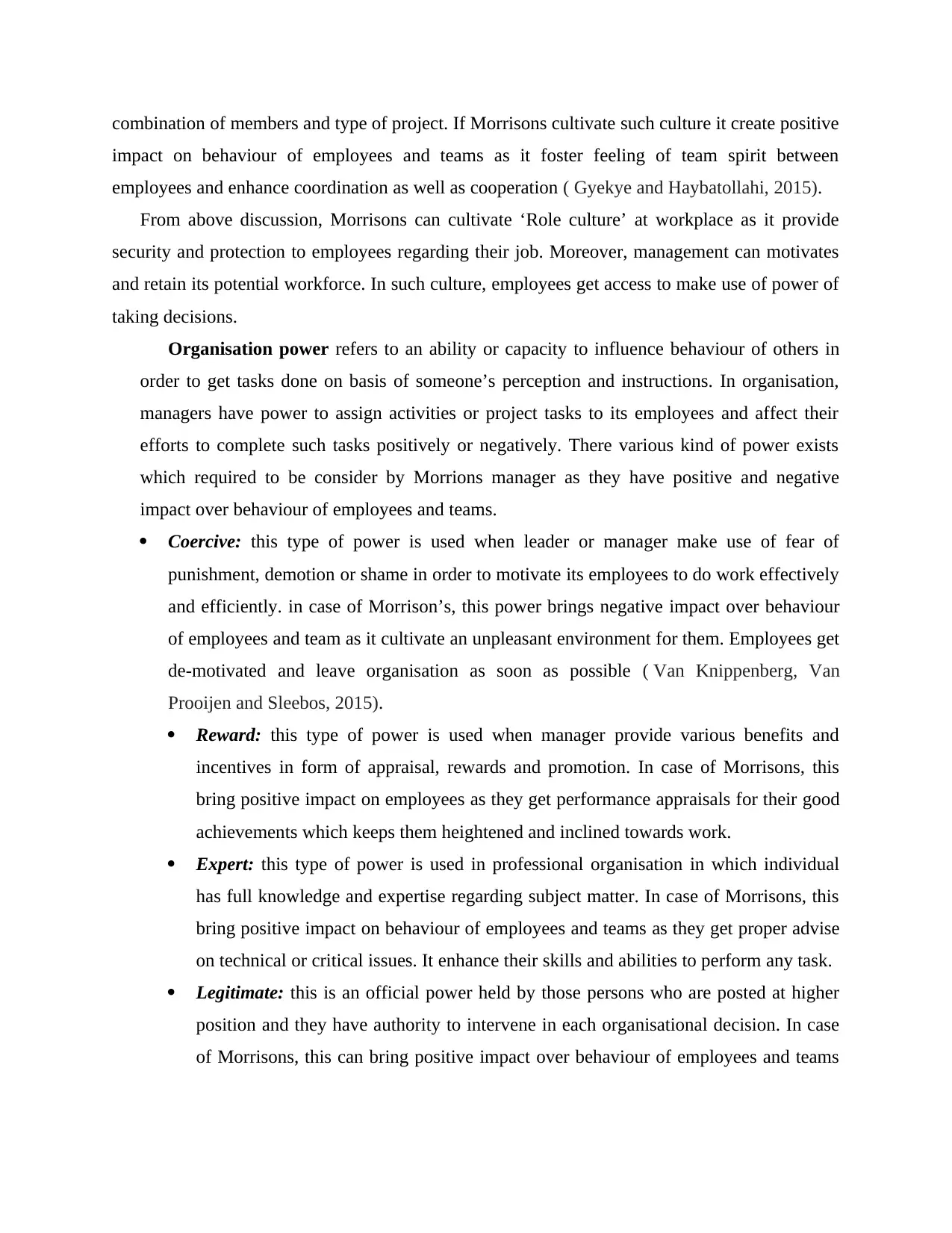
combination of members and type of project. If Morrisons cultivate such culture it create positive
impact on behaviour of employees and teams as it foster feeling of team spirit between
employees and enhance coordination as well as cooperation ( Gyekye and Haybatollahi, 2015).
From above discussion, Morrisons can cultivate ‘Role culture’ at workplace as it provide
security and protection to employees regarding their job. Moreover, management can motivates
and retain its potential workforce. In such culture, employees get access to make use of power of
taking decisions.
Organisation power refers to an ability or capacity to influence behaviour of others in
order to get tasks done on basis of someone’s perception and instructions. In organisation,
managers have power to assign activities or project tasks to its employees and affect their
efforts to complete such tasks positively or negatively. There various kind of power exists
which required to be consider by Morrions manager as they have positive and negative
impact over behaviour of employees and teams.
Coercive: this type of power is used when leader or manager make use of fear of
punishment, demotion or shame in order to motivate its employees to do work effectively
and efficiently. in case of Morrison’s, this power brings negative impact over behaviour
of employees and team as it cultivate an unpleasant environment for them. Employees get
de-motivated and leave organisation as soon as possible ( Van Knippenberg, Van
Prooijen and Sleebos, 2015).
Reward: this type of power is used when manager provide various benefits and
incentives in form of appraisal, rewards and promotion. In case of Morrisons, this
bring positive impact on employees as they get performance appraisals for their good
achievements which keeps them heightened and inclined towards work.
Expert: this type of power is used in professional organisation in which individual
has full knowledge and expertise regarding subject matter. In case of Morrisons, this
bring positive impact on behaviour of employees and teams as they get proper advise
on technical or critical issues. It enhance their skills and abilities to perform any task.
Legitimate: this is an official power held by those persons who are posted at higher
position and they have authority to intervene in each organisational decision. In case
of Morrisons, this can bring positive impact over behaviour of employees and teams
impact on behaviour of employees and teams as it foster feeling of team spirit between
employees and enhance coordination as well as cooperation ( Gyekye and Haybatollahi, 2015).
From above discussion, Morrisons can cultivate ‘Role culture’ at workplace as it provide
security and protection to employees regarding their job. Moreover, management can motivates
and retain its potential workforce. In such culture, employees get access to make use of power of
taking decisions.
Organisation power refers to an ability or capacity to influence behaviour of others in
order to get tasks done on basis of someone’s perception and instructions. In organisation,
managers have power to assign activities or project tasks to its employees and affect their
efforts to complete such tasks positively or negatively. There various kind of power exists
which required to be consider by Morrions manager as they have positive and negative
impact over behaviour of employees and teams.
Coercive: this type of power is used when leader or manager make use of fear of
punishment, demotion or shame in order to motivate its employees to do work effectively
and efficiently. in case of Morrison’s, this power brings negative impact over behaviour
of employees and team as it cultivate an unpleasant environment for them. Employees get
de-motivated and leave organisation as soon as possible ( Van Knippenberg, Van
Prooijen and Sleebos, 2015).
Reward: this type of power is used when manager provide various benefits and
incentives in form of appraisal, rewards and promotion. In case of Morrisons, this
bring positive impact on employees as they get performance appraisals for their good
achievements which keeps them heightened and inclined towards work.
Expert: this type of power is used in professional organisation in which individual
has full knowledge and expertise regarding subject matter. In case of Morrisons, this
bring positive impact on behaviour of employees and teams as they get proper advise
on technical or critical issues. It enhance their skills and abilities to perform any task.
Legitimate: this is an official power held by those persons who are posted at higher
position and they have authority to intervene in each organisational decision. In case
of Morrisons, this can bring positive impact over behaviour of employees and teams
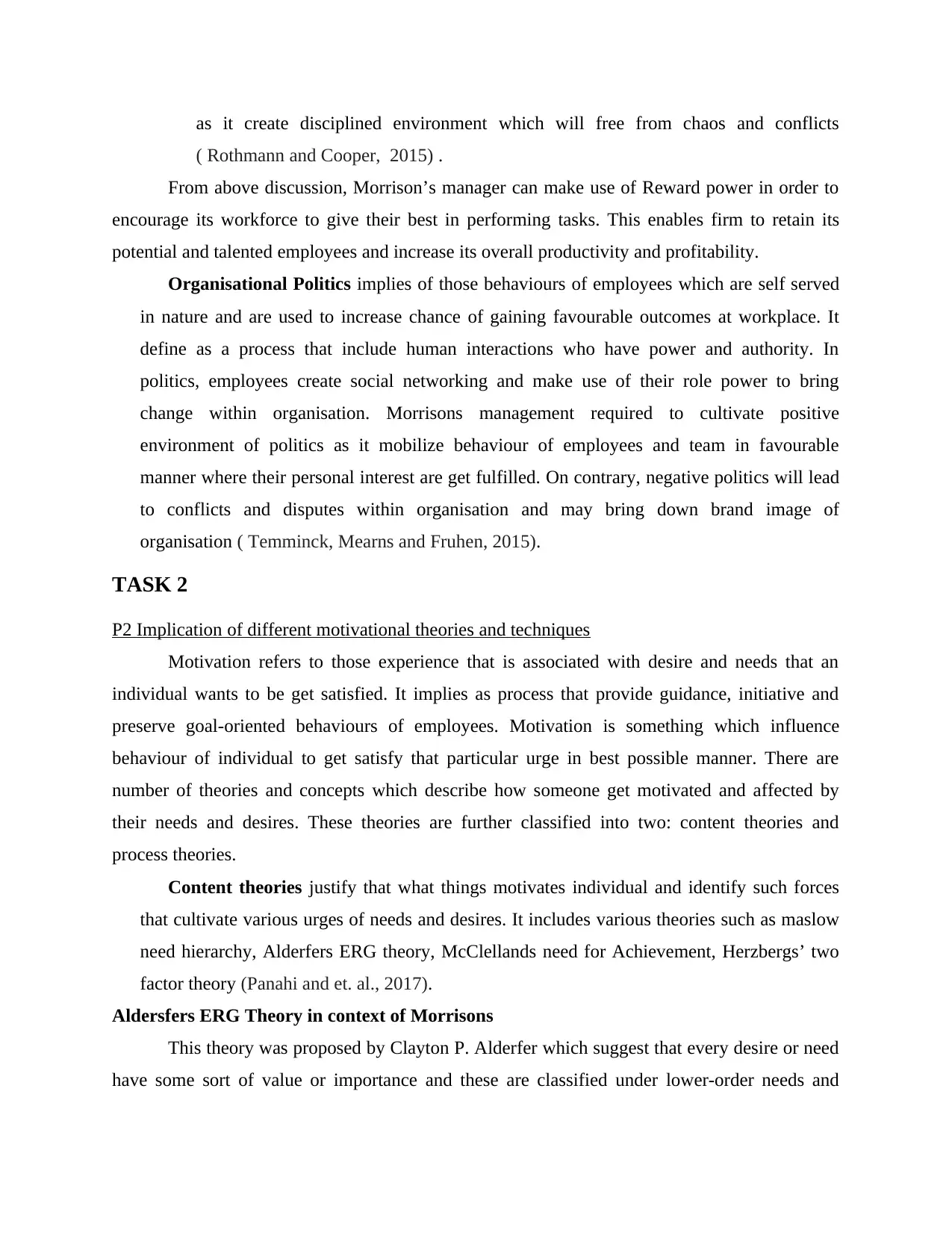
as it create disciplined environment which will free from chaos and conflicts
( Rothmann and Cooper, 2015) .
From above discussion, Morrison’s manager can make use of Reward power in order to
encourage its workforce to give their best in performing tasks. This enables firm to retain its
potential and talented employees and increase its overall productivity and profitability.
Organisational Politics implies of those behaviours of employees which are self served
in nature and are used to increase chance of gaining favourable outcomes at workplace. It
define as a process that include human interactions who have power and authority. In
politics, employees create social networking and make use of their role power to bring
change within organisation. Morrisons management required to cultivate positive
environment of politics as it mobilize behaviour of employees and team in favourable
manner where their personal interest are get fulfilled. On contrary, negative politics will lead
to conflicts and disputes within organisation and may bring down brand image of
organisation ( Temminck, Mearns and Fruhen, 2015).
TASK 2
P2 Implication of different motivational theories and techniques
Motivation refers to those experience that is associated with desire and needs that an
individual wants to be get satisfied. It implies as process that provide guidance, initiative and
preserve goal-oriented behaviours of employees. Motivation is something which influence
behaviour of individual to get satisfy that particular urge in best possible manner. There are
number of theories and concepts which describe how someone get motivated and affected by
their needs and desires. These theories are further classified into two: content theories and
process theories.
Content theories justify that what things motivates individual and identify such forces
that cultivate various urges of needs and desires. It includes various theories such as maslow
need hierarchy, Alderfers ERG theory, McClellands need for Achievement, Herzbergs’ two
factor theory (Panahi and et. al., 2017).
Aldersfers ERG Theory in context of Morrisons
This theory was proposed by Clayton P. Alderfer which suggest that every desire or need
have some sort of value or importance and these are classified under lower-order needs and
( Rothmann and Cooper, 2015) .
From above discussion, Morrison’s manager can make use of Reward power in order to
encourage its workforce to give their best in performing tasks. This enables firm to retain its
potential and talented employees and increase its overall productivity and profitability.
Organisational Politics implies of those behaviours of employees which are self served
in nature and are used to increase chance of gaining favourable outcomes at workplace. It
define as a process that include human interactions who have power and authority. In
politics, employees create social networking and make use of their role power to bring
change within organisation. Morrisons management required to cultivate positive
environment of politics as it mobilize behaviour of employees and team in favourable
manner where their personal interest are get fulfilled. On contrary, negative politics will lead
to conflicts and disputes within organisation and may bring down brand image of
organisation ( Temminck, Mearns and Fruhen, 2015).
TASK 2
P2 Implication of different motivational theories and techniques
Motivation refers to those experience that is associated with desire and needs that an
individual wants to be get satisfied. It implies as process that provide guidance, initiative and
preserve goal-oriented behaviours of employees. Motivation is something which influence
behaviour of individual to get satisfy that particular urge in best possible manner. There are
number of theories and concepts which describe how someone get motivated and affected by
their needs and desires. These theories are further classified into two: content theories and
process theories.
Content theories justify that what things motivates individual and identify such forces
that cultivate various urges of needs and desires. It includes various theories such as maslow
need hierarchy, Alderfers ERG theory, McClellands need for Achievement, Herzbergs’ two
factor theory (Panahi and et. al., 2017).
Aldersfers ERG Theory in context of Morrisons
This theory was proposed by Clayton P. Alderfer which suggest that every desire or need
have some sort of value or importance and these are classified under lower-order needs and
⊘ This is a preview!⊘
Do you want full access?
Subscribe today to unlock all pages.

Trusted by 1+ million students worldwide
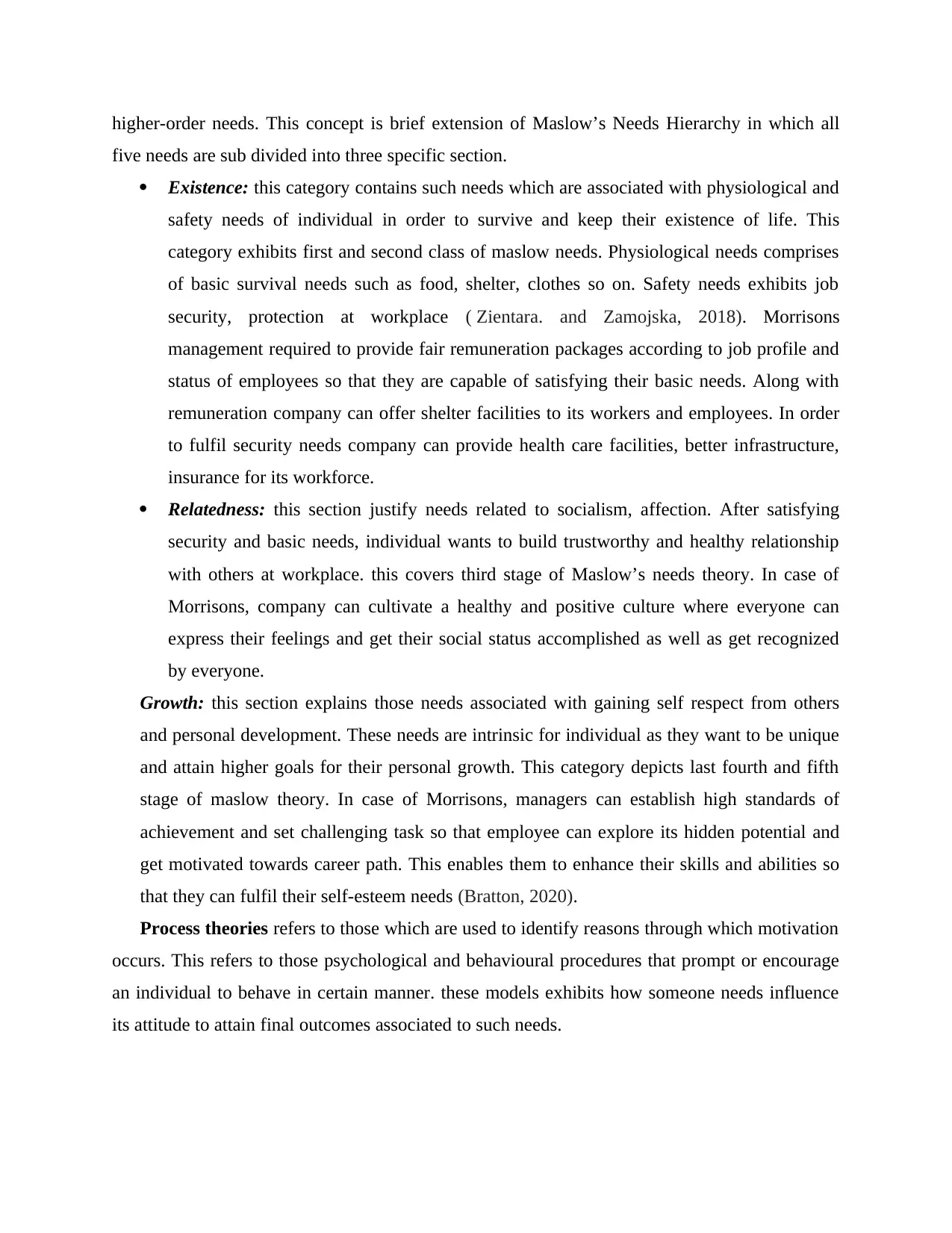
higher-order needs. This concept is brief extension of Maslow’s Needs Hierarchy in which all
five needs are sub divided into three specific section.
Existence: this category contains such needs which are associated with physiological and
safety needs of individual in order to survive and keep their existence of life. This
category exhibits first and second class of maslow needs. Physiological needs comprises
of basic survival needs such as food, shelter, clothes so on. Safety needs exhibits job
security, protection at workplace ( Zientara. and Zamojska, 2018). Morrisons
management required to provide fair remuneration packages according to job profile and
status of employees so that they are capable of satisfying their basic needs. Along with
remuneration company can offer shelter facilities to its workers and employees. In order
to fulfil security needs company can provide health care facilities, better infrastructure,
insurance for its workforce.
Relatedness: this section justify needs related to socialism, affection. After satisfying
security and basic needs, individual wants to build trustworthy and healthy relationship
with others at workplace. this covers third stage of Maslow’s needs theory. In case of
Morrisons, company can cultivate a healthy and positive culture where everyone can
express their feelings and get their social status accomplished as well as get recognized
by everyone.
Growth: this section explains those needs associated with gaining self respect from others
and personal development. These needs are intrinsic for individual as they want to be unique
and attain higher goals for their personal growth. This category depicts last fourth and fifth
stage of maslow theory. In case of Morrisons, managers can establish high standards of
achievement and set challenging task so that employee can explore its hidden potential and
get motivated towards career path. This enables them to enhance their skills and abilities so
that they can fulfil their self-esteem needs (Bratton, 2020).
Process theories refers to those which are used to identify reasons through which motivation
occurs. This refers to those psychological and behavioural procedures that prompt or encourage
an individual to behave in certain manner. these models exhibits how someone needs influence
its attitude to attain final outcomes associated to such needs.
five needs are sub divided into three specific section.
Existence: this category contains such needs which are associated with physiological and
safety needs of individual in order to survive and keep their existence of life. This
category exhibits first and second class of maslow needs. Physiological needs comprises
of basic survival needs such as food, shelter, clothes so on. Safety needs exhibits job
security, protection at workplace ( Zientara. and Zamojska, 2018). Morrisons
management required to provide fair remuneration packages according to job profile and
status of employees so that they are capable of satisfying their basic needs. Along with
remuneration company can offer shelter facilities to its workers and employees. In order
to fulfil security needs company can provide health care facilities, better infrastructure,
insurance for its workforce.
Relatedness: this section justify needs related to socialism, affection. After satisfying
security and basic needs, individual wants to build trustworthy and healthy relationship
with others at workplace. this covers third stage of Maslow’s needs theory. In case of
Morrisons, company can cultivate a healthy and positive culture where everyone can
express their feelings and get their social status accomplished as well as get recognized
by everyone.
Growth: this section explains those needs associated with gaining self respect from others
and personal development. These needs are intrinsic for individual as they want to be unique
and attain higher goals for their personal growth. This category depicts last fourth and fifth
stage of maslow theory. In case of Morrisons, managers can establish high standards of
achievement and set challenging task so that employee can explore its hidden potential and
get motivated towards career path. This enables them to enhance their skills and abilities so
that they can fulfil their self-esteem needs (Bratton, 2020).
Process theories refers to those which are used to identify reasons through which motivation
occurs. This refers to those psychological and behavioural procedures that prompt or encourage
an individual to behave in certain manner. these models exhibits how someone needs influence
its attitude to attain final outcomes associated to such needs.
Paraphrase This Document
Need a fresh take? Get an instant paraphrase of this document with our AI Paraphraser
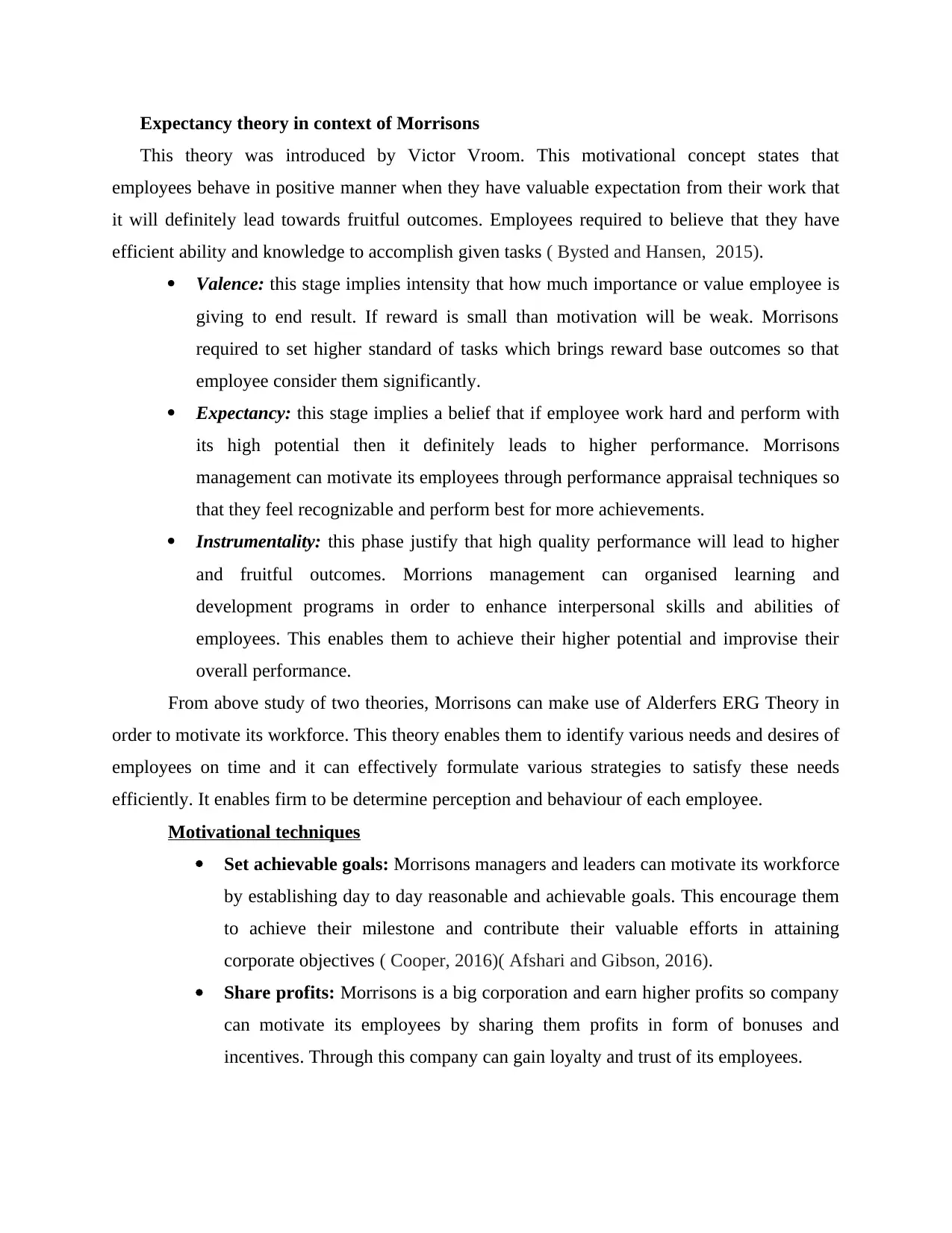
Expectancy theory in context of Morrisons
This theory was introduced by Victor Vroom. This motivational concept states that
employees behave in positive manner when they have valuable expectation from their work that
it will definitely lead towards fruitful outcomes. Employees required to believe that they have
efficient ability and knowledge to accomplish given tasks ( Bysted and Hansen, 2015).
Valence: this stage implies intensity that how much importance or value employee is
giving to end result. If reward is small than motivation will be weak. Morrisons
required to set higher standard of tasks which brings reward base outcomes so that
employee consider them significantly.
Expectancy: this stage implies a belief that if employee work hard and perform with
its high potential then it definitely leads to higher performance. Morrisons
management can motivate its employees through performance appraisal techniques so
that they feel recognizable and perform best for more achievements.
Instrumentality: this phase justify that high quality performance will lead to higher
and fruitful outcomes. Morrions management can organised learning and
development programs in order to enhance interpersonal skills and abilities of
employees. This enables them to achieve their higher potential and improvise their
overall performance.
From above study of two theories, Morrisons can make use of Alderfers ERG Theory in
order to motivate its workforce. This theory enables them to identify various needs and desires of
employees on time and it can effectively formulate various strategies to satisfy these needs
efficiently. It enables firm to be determine perception and behaviour of each employee.
Motivational techniques
Set achievable goals: Morrisons managers and leaders can motivate its workforce
by establishing day to day reasonable and achievable goals. This encourage them
to achieve their milestone and contribute their valuable efforts in attaining
corporate objectives ( Cooper, 2016)( Afshari and Gibson, 2016).
Share profits: Morrisons is a big corporation and earn higher profits so company
can motivate its employees by sharing them profits in form of bonuses and
incentives. Through this company can gain loyalty and trust of its employees.
This theory was introduced by Victor Vroom. This motivational concept states that
employees behave in positive manner when they have valuable expectation from their work that
it will definitely lead towards fruitful outcomes. Employees required to believe that they have
efficient ability and knowledge to accomplish given tasks ( Bysted and Hansen, 2015).
Valence: this stage implies intensity that how much importance or value employee is
giving to end result. If reward is small than motivation will be weak. Morrisons
required to set higher standard of tasks which brings reward base outcomes so that
employee consider them significantly.
Expectancy: this stage implies a belief that if employee work hard and perform with
its high potential then it definitely leads to higher performance. Morrisons
management can motivate its employees through performance appraisal techniques so
that they feel recognizable and perform best for more achievements.
Instrumentality: this phase justify that high quality performance will lead to higher
and fruitful outcomes. Morrions management can organised learning and
development programs in order to enhance interpersonal skills and abilities of
employees. This enables them to achieve their higher potential and improvise their
overall performance.
From above study of two theories, Morrisons can make use of Alderfers ERG Theory in
order to motivate its workforce. This theory enables them to identify various needs and desires of
employees on time and it can effectively formulate various strategies to satisfy these needs
efficiently. It enables firm to be determine perception and behaviour of each employee.
Motivational techniques
Set achievable goals: Morrisons managers and leaders can motivate its workforce
by establishing day to day reasonable and achievable goals. This encourage them
to achieve their milestone and contribute their valuable efforts in attaining
corporate objectives ( Cooper, 2016)( Afshari and Gibson, 2016).
Share profits: Morrisons is a big corporation and earn higher profits so company
can motivate its employees by sharing them profits in form of bonuses and
incentives. Through this company can gain loyalty and trust of its employees.
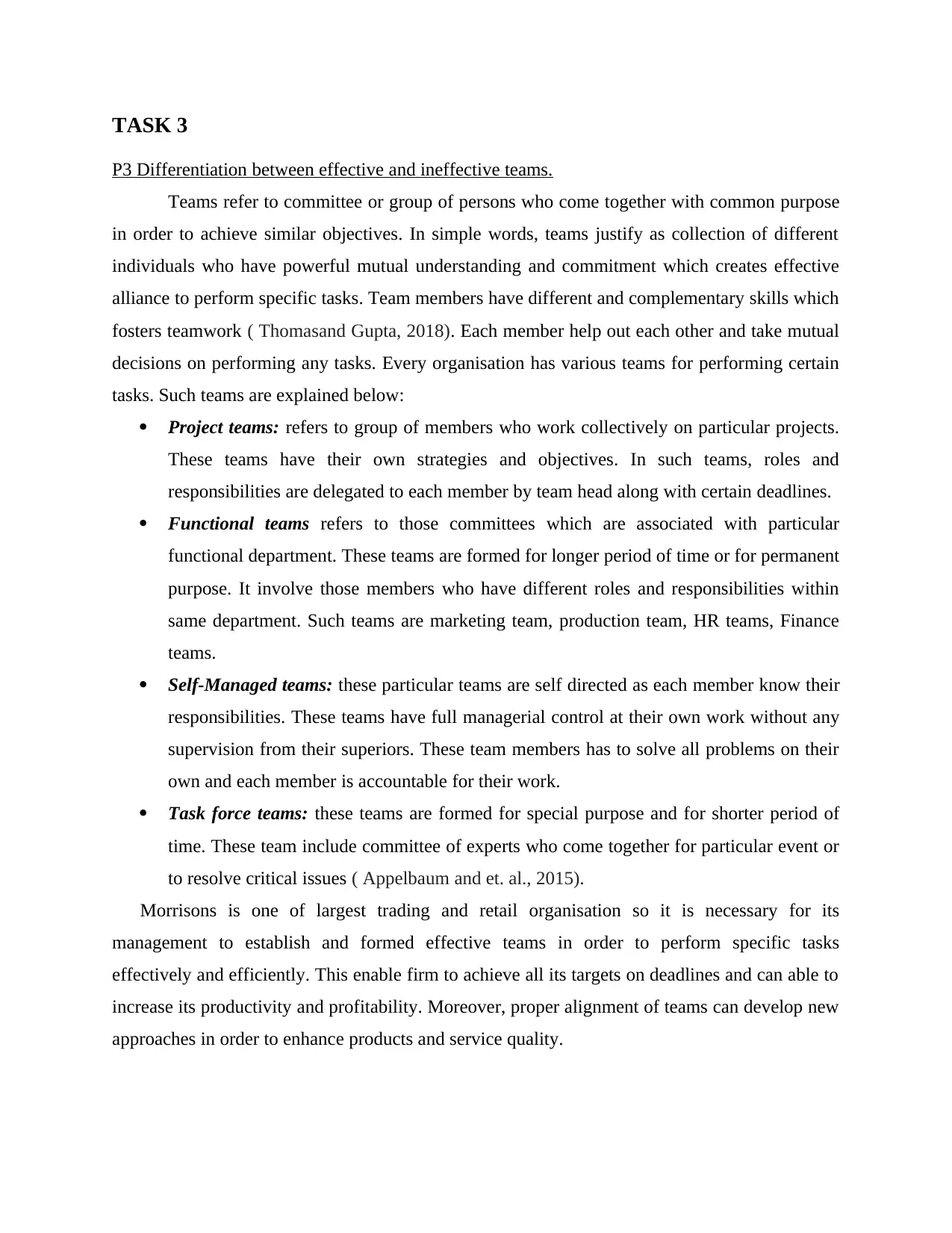
TASK 3
P3 Differentiation between effective and ineffective teams.
Teams refer to committee or group of persons who come together with common purpose
in order to achieve similar objectives. In simple words, teams justify as collection of different
individuals who have powerful mutual understanding and commitment which creates effective
alliance to perform specific tasks. Team members have different and complementary skills which
fosters teamwork ( Thomasand Gupta, 2018). Each member help out each other and take mutual
decisions on performing any tasks. Every organisation has various teams for performing certain
tasks. Such teams are explained below:
Project teams: refers to group of members who work collectively on particular projects.
These teams have their own strategies and objectives. In such teams, roles and
responsibilities are delegated to each member by team head along with certain deadlines.
Functional teams refers to those committees which are associated with particular
functional department. These teams are formed for longer period of time or for permanent
purpose. It involve those members who have different roles and responsibilities within
same department. Such teams are marketing team, production team, HR teams, Finance
teams.
Self-Managed teams: these particular teams are self directed as each member know their
responsibilities. These teams have full managerial control at their own work without any
supervision from their superiors. These team members has to solve all problems on their
own and each member is accountable for their work.
Task force teams: these teams are formed for special purpose and for shorter period of
time. These team include committee of experts who come together for particular event or
to resolve critical issues ( Appelbaum and et. al., 2015).
Morrisons is one of largest trading and retail organisation so it is necessary for its
management to establish and formed effective teams in order to perform specific tasks
effectively and efficiently. This enable firm to achieve all its targets on deadlines and can able to
increase its productivity and profitability. Moreover, proper alignment of teams can develop new
approaches in order to enhance products and service quality.
P3 Differentiation between effective and ineffective teams.
Teams refer to committee or group of persons who come together with common purpose
in order to achieve similar objectives. In simple words, teams justify as collection of different
individuals who have powerful mutual understanding and commitment which creates effective
alliance to perform specific tasks. Team members have different and complementary skills which
fosters teamwork ( Thomasand Gupta, 2018). Each member help out each other and take mutual
decisions on performing any tasks. Every organisation has various teams for performing certain
tasks. Such teams are explained below:
Project teams: refers to group of members who work collectively on particular projects.
These teams have their own strategies and objectives. In such teams, roles and
responsibilities are delegated to each member by team head along with certain deadlines.
Functional teams refers to those committees which are associated with particular
functional department. These teams are formed for longer period of time or for permanent
purpose. It involve those members who have different roles and responsibilities within
same department. Such teams are marketing team, production team, HR teams, Finance
teams.
Self-Managed teams: these particular teams are self directed as each member know their
responsibilities. These teams have full managerial control at their own work without any
supervision from their superiors. These team members has to solve all problems on their
own and each member is accountable for their work.
Task force teams: these teams are formed for special purpose and for shorter period of
time. These team include committee of experts who come together for particular event or
to resolve critical issues ( Appelbaum and et. al., 2015).
Morrisons is one of largest trading and retail organisation so it is necessary for its
management to establish and formed effective teams in order to perform specific tasks
effectively and efficiently. This enable firm to achieve all its targets on deadlines and can able to
increase its productivity and profitability. Moreover, proper alignment of teams can develop new
approaches in order to enhance products and service quality.
⊘ This is a preview!⊘
Do you want full access?
Subscribe today to unlock all pages.

Trusted by 1+ million students worldwide
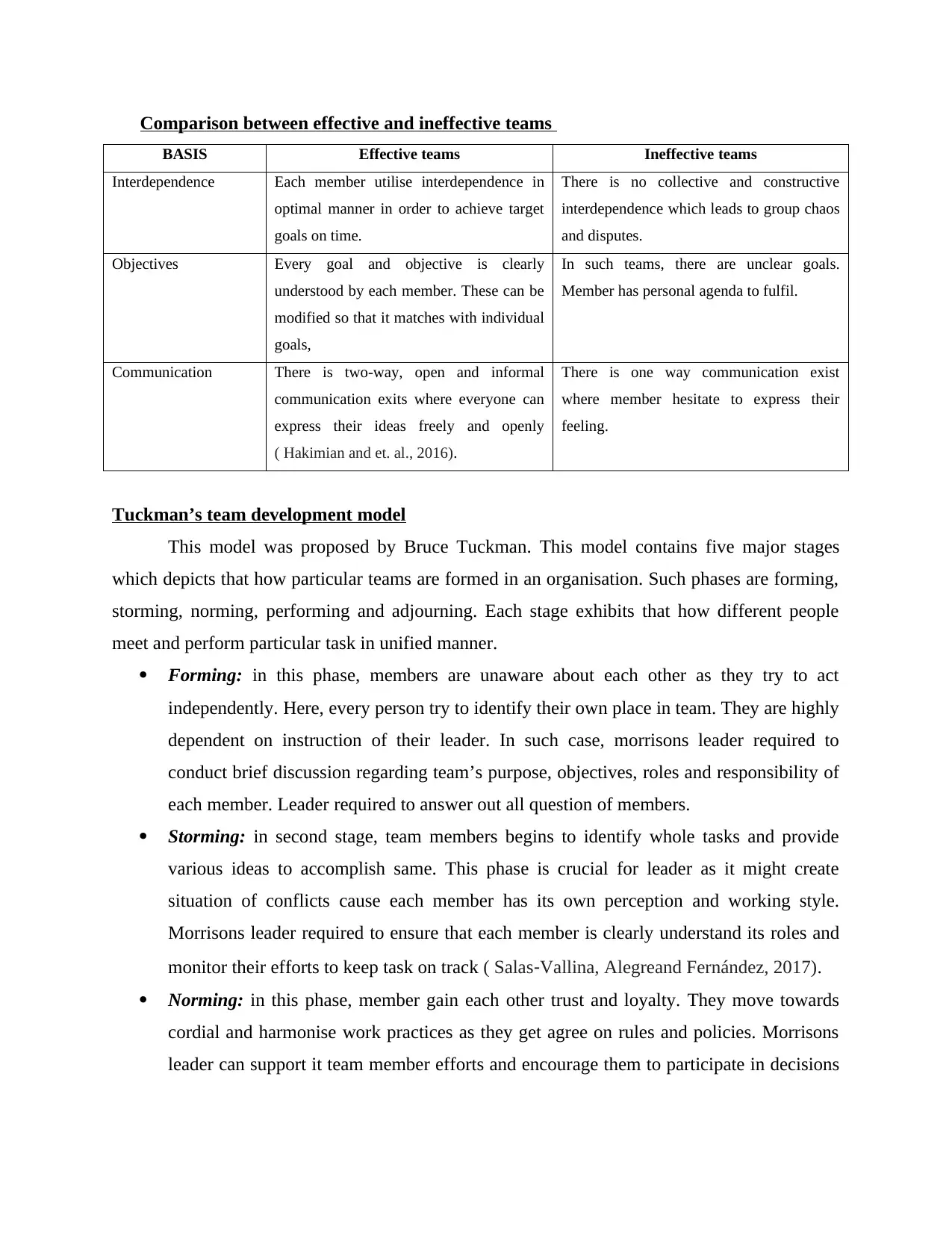
Comparison between effective and ineffective teams
BASIS Effective teams Ineffective teams
Interdependence Each member utilise interdependence in
optimal manner in order to achieve target
goals on time.
There is no collective and constructive
interdependence which leads to group chaos
and disputes.
Objectives Every goal and objective is clearly
understood by each member. These can be
modified so that it matches with individual
goals,
In such teams, there are unclear goals.
Member has personal agenda to fulfil.
Communication There is two-way, open and informal
communication exits where everyone can
express their ideas freely and openly
( Hakimian and et. al., 2016).
There is one way communication exist
where member hesitate to express their
feeling.
Tuckman’s team development model
This model was proposed by Bruce Tuckman. This model contains five major stages
which depicts that how particular teams are formed in an organisation. Such phases are forming,
storming, norming, performing and adjourning. Each stage exhibits that how different people
meet and perform particular task in unified manner.
Forming: in this phase, members are unaware about each other as they try to act
independently. Here, every person try to identify their own place in team. They are highly
dependent on instruction of their leader. In such case, morrisons leader required to
conduct brief discussion regarding team’s purpose, objectives, roles and responsibility of
each member. Leader required to answer out all question of members.
Storming: in second stage, team members begins to identify whole tasks and provide
various ideas to accomplish same. This phase is crucial for leader as it might create
situation of conflicts cause each member has its own perception and working style.
Morrisons leader required to ensure that each member is clearly understand its roles and
monitor their efforts to keep task on track ( Salas‐Vallina, Alegreand Fernández, 2017).
Norming: in this phase, member gain each other trust and loyalty. They move towards
cordial and harmonise work practices as they get agree on rules and policies. Morrisons
leader can support it team member efforts and encourage them to participate in decisions
BASIS Effective teams Ineffective teams
Interdependence Each member utilise interdependence in
optimal manner in order to achieve target
goals on time.
There is no collective and constructive
interdependence which leads to group chaos
and disputes.
Objectives Every goal and objective is clearly
understood by each member. These can be
modified so that it matches with individual
goals,
In such teams, there are unclear goals.
Member has personal agenda to fulfil.
Communication There is two-way, open and informal
communication exits where everyone can
express their ideas freely and openly
( Hakimian and et. al., 2016).
There is one way communication exist
where member hesitate to express their
feeling.
Tuckman’s team development model
This model was proposed by Bruce Tuckman. This model contains five major stages
which depicts that how particular teams are formed in an organisation. Such phases are forming,
storming, norming, performing and adjourning. Each stage exhibits that how different people
meet and perform particular task in unified manner.
Forming: in this phase, members are unaware about each other as they try to act
independently. Here, every person try to identify their own place in team. They are highly
dependent on instruction of their leader. In such case, morrisons leader required to
conduct brief discussion regarding team’s purpose, objectives, roles and responsibility of
each member. Leader required to answer out all question of members.
Storming: in second stage, team members begins to identify whole tasks and provide
various ideas to accomplish same. This phase is crucial for leader as it might create
situation of conflicts cause each member has its own perception and working style.
Morrisons leader required to ensure that each member is clearly understand its roles and
monitor their efforts to keep task on track ( Salas‐Vallina, Alegreand Fernández, 2017).
Norming: in this phase, member gain each other trust and loyalty. They move towards
cordial and harmonise work practices as they get agree on rules and policies. Morrisons
leader can support it team member efforts and encourage them to participate in decisions
Paraphrase This Document
Need a fresh take? Get an instant paraphrase of this document with our AI Paraphraser
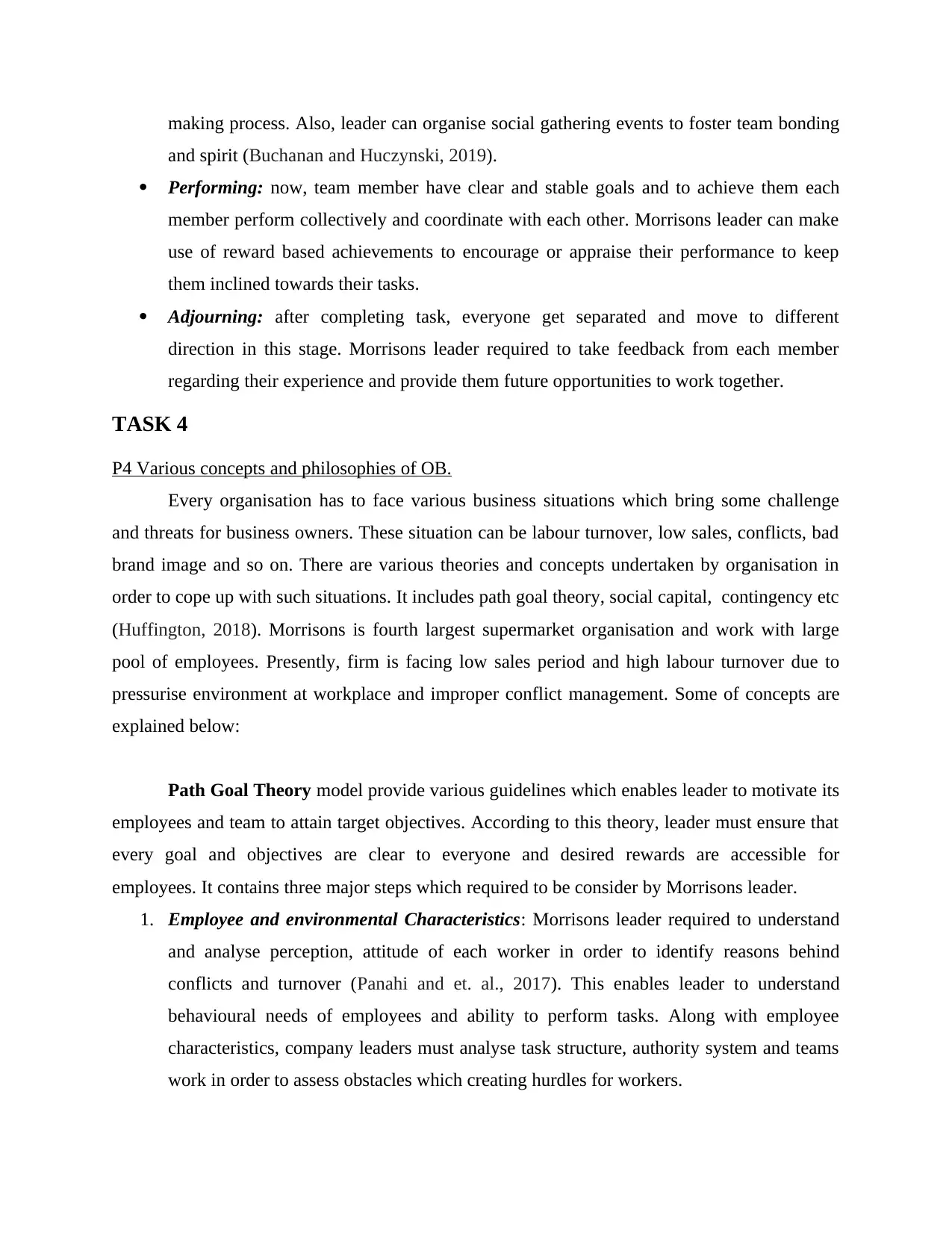
making process. Also, leader can organise social gathering events to foster team bonding
and spirit (Buchanan and Huczynski, 2019).
Performing: now, team member have clear and stable goals and to achieve them each
member perform collectively and coordinate with each other. Morrisons leader can make
use of reward based achievements to encourage or appraise their performance to keep
them inclined towards their tasks.
Adjourning: after completing task, everyone get separated and move to different
direction in this stage. Morrisons leader required to take feedback from each member
regarding their experience and provide them future opportunities to work together.
TASK 4
P4 Various concepts and philosophies of OB.
Every organisation has to face various business situations which bring some challenge
and threats for business owners. These situation can be labour turnover, low sales, conflicts, bad
brand image and so on. There are various theories and concepts undertaken by organisation in
order to cope up with such situations. It includes path goal theory, social capital, contingency etc
(Huffington, 2018). Morrisons is fourth largest supermarket organisation and work with large
pool of employees. Presently, firm is facing low sales period and high labour turnover due to
pressurise environment at workplace and improper conflict management. Some of concepts are
explained below:
Path Goal Theory model provide various guidelines which enables leader to motivate its
employees and team to attain target objectives. According to this theory, leader must ensure that
every goal and objectives are clear to everyone and desired rewards are accessible for
employees. It contains three major steps which required to be consider by Morrisons leader.
1. Employee and environmental Characteristics: Morrisons leader required to understand
and analyse perception, attitude of each worker in order to identify reasons behind
conflicts and turnover (Panahi and et. al., 2017). This enables leader to understand
behavioural needs of employees and ability to perform tasks. Along with employee
characteristics, company leaders must analyse task structure, authority system and teams
work in order to assess obstacles which creating hurdles for workers.
and spirit (Buchanan and Huczynski, 2019).
Performing: now, team member have clear and stable goals and to achieve them each
member perform collectively and coordinate with each other. Morrisons leader can make
use of reward based achievements to encourage or appraise their performance to keep
them inclined towards their tasks.
Adjourning: after completing task, everyone get separated and move to different
direction in this stage. Morrisons leader required to take feedback from each member
regarding their experience and provide them future opportunities to work together.
TASK 4
P4 Various concepts and philosophies of OB.
Every organisation has to face various business situations which bring some challenge
and threats for business owners. These situation can be labour turnover, low sales, conflicts, bad
brand image and so on. There are various theories and concepts undertaken by organisation in
order to cope up with such situations. It includes path goal theory, social capital, contingency etc
(Huffington, 2018). Morrisons is fourth largest supermarket organisation and work with large
pool of employees. Presently, firm is facing low sales period and high labour turnover due to
pressurise environment at workplace and improper conflict management. Some of concepts are
explained below:
Path Goal Theory model provide various guidelines which enables leader to motivate its
employees and team to attain target objectives. According to this theory, leader must ensure that
every goal and objectives are clear to everyone and desired rewards are accessible for
employees. It contains three major steps which required to be consider by Morrisons leader.
1. Employee and environmental Characteristics: Morrisons leader required to understand
and analyse perception, attitude of each worker in order to identify reasons behind
conflicts and turnover (Panahi and et. al., 2017). This enables leader to understand
behavioural needs of employees and ability to perform tasks. Along with employee
characteristics, company leaders must analyse task structure, authority system and teams
work in order to assess obstacles which creating hurdles for workers.
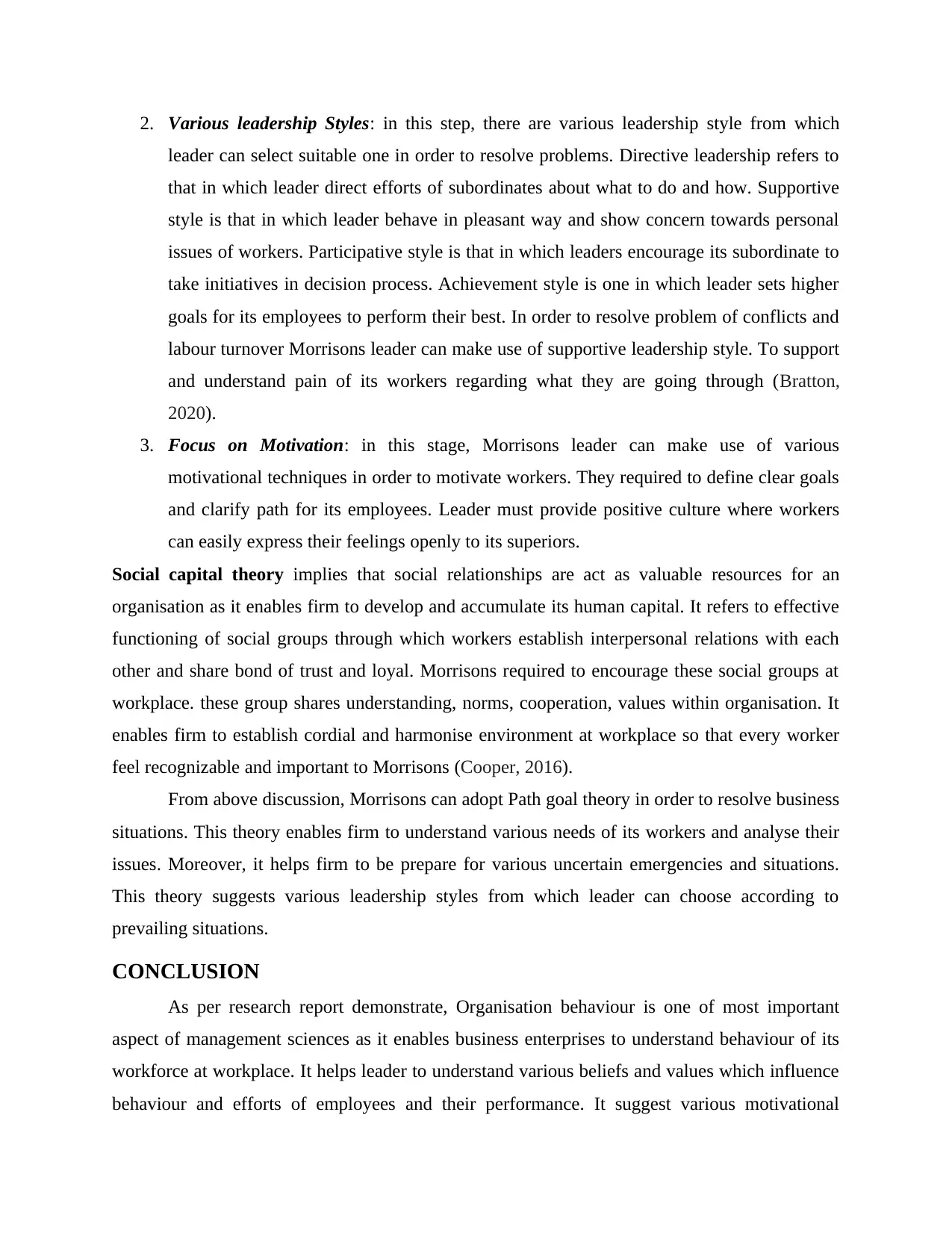
2. Various leadership Styles: in this step, there are various leadership style from which
leader can select suitable one in order to resolve problems. Directive leadership refers to
that in which leader direct efforts of subordinates about what to do and how. Supportive
style is that in which leader behave in pleasant way and show concern towards personal
issues of workers. Participative style is that in which leaders encourage its subordinate to
take initiatives in decision process. Achievement style is one in which leader sets higher
goals for its employees to perform their best. In order to resolve problem of conflicts and
labour turnover Morrisons leader can make use of supportive leadership style. To support
and understand pain of its workers regarding what they are going through (Bratton,
2020).
3. Focus on Motivation: in this stage, Morrisons leader can make use of various
motivational techniques in order to motivate workers. They required to define clear goals
and clarify path for its employees. Leader must provide positive culture where workers
can easily express their feelings openly to its superiors.
Social capital theory implies that social relationships are act as valuable resources for an
organisation as it enables firm to develop and accumulate its human capital. It refers to effective
functioning of social groups through which workers establish interpersonal relations with each
other and share bond of trust and loyal. Morrisons required to encourage these social groups at
workplace. these group shares understanding, norms, cooperation, values within organisation. It
enables firm to establish cordial and harmonise environment at workplace so that every worker
feel recognizable and important to Morrisons (Cooper, 2016).
From above discussion, Morrisons can adopt Path goal theory in order to resolve business
situations. This theory enables firm to understand various needs of its workers and analyse their
issues. Moreover, it helps firm to be prepare for various uncertain emergencies and situations.
This theory suggests various leadership styles from which leader can choose according to
prevailing situations.
CONCLUSION
As per research report demonstrate, Organisation behaviour is one of most important
aspect of management sciences as it enables business enterprises to understand behaviour of its
workforce at workplace. It helps leader to understand various beliefs and values which influence
behaviour and efforts of employees and their performance. It suggest various motivational
leader can select suitable one in order to resolve problems. Directive leadership refers to
that in which leader direct efforts of subordinates about what to do and how. Supportive
style is that in which leader behave in pleasant way and show concern towards personal
issues of workers. Participative style is that in which leaders encourage its subordinate to
take initiatives in decision process. Achievement style is one in which leader sets higher
goals for its employees to perform their best. In order to resolve problem of conflicts and
labour turnover Morrisons leader can make use of supportive leadership style. To support
and understand pain of its workers regarding what they are going through (Bratton,
2020).
3. Focus on Motivation: in this stage, Morrisons leader can make use of various
motivational techniques in order to motivate workers. They required to define clear goals
and clarify path for its employees. Leader must provide positive culture where workers
can easily express their feelings openly to its superiors.
Social capital theory implies that social relationships are act as valuable resources for an
organisation as it enables firm to develop and accumulate its human capital. It refers to effective
functioning of social groups through which workers establish interpersonal relations with each
other and share bond of trust and loyal. Morrisons required to encourage these social groups at
workplace. these group shares understanding, norms, cooperation, values within organisation. It
enables firm to establish cordial and harmonise environment at workplace so that every worker
feel recognizable and important to Morrisons (Cooper, 2016).
From above discussion, Morrisons can adopt Path goal theory in order to resolve business
situations. This theory enables firm to understand various needs of its workers and analyse their
issues. Moreover, it helps firm to be prepare for various uncertain emergencies and situations.
This theory suggests various leadership styles from which leader can choose according to
prevailing situations.
CONCLUSION
As per research report demonstrate, Organisation behaviour is one of most important
aspect of management sciences as it enables business enterprises to understand behaviour of its
workforce at workplace. It helps leader to understand various beliefs and values which influence
behaviour and efforts of employees and their performance. It suggest various motivational
⊘ This is a preview!⊘
Do you want full access?
Subscribe today to unlock all pages.

Trusted by 1+ million students worldwide
1 out of 14
Related Documents
Your All-in-One AI-Powered Toolkit for Academic Success.
+13062052269
info@desklib.com
Available 24*7 on WhatsApp / Email
![[object Object]](/_next/static/media/star-bottom.7253800d.svg)
Unlock your academic potential
Copyright © 2020–2025 A2Z Services. All Rights Reserved. Developed and managed by ZUCOL.



